Spatiotemporal Dynamics and Evolution of Grain Cropping Patterns in Northeast China: Insights from Remote Sensing and Spatial Overlay Analysis
Abstract
1. Introduction
2. Materials and Methods
2.1. Study Area
2.2. Data Sources and Processing
2.3. Methods
2.3.1. Spatial Overlay Analysis
2.3.2. Land Use Dynamic Degree
2.3.3. Land Use Transition Matrix
2.3.4. The Equiangular Sector Method for Cropping Patterns
3. Results
3.1. The Characteristics of Interannual Variation in the Structure of Grain Cropping
3.2. Identification of Grain Cropping Patterns
3.3. Evolution of Grain Cropping Patterns
3.3.1. Overall Changes in Crain Cropping Patterns
3.3.2. Conversion of Grain Cropping Patterns
3.3.3. Analysis of the Spatial Evolution of Grain Cropping Patterns
4. Discussion
4.1. Natural Factors in the Evolution of Grain Cropping Patterns
4.2. Technological Factors in the Evolution of Grain Cropping Patterns
4.3. Policy Factors in the Evolution of Grain Cropping Patterns
4.4. Driving Mechanisms of the Evolution of Grain Cropping Patterns
4.5. Comparisons and Contrasts with Similar Studies, and Prospects
5. Conclusions
Author Contributions
Funding
Institutional Review Board Statement
Informed Consent Statement
Data Availability Statement
Acknowledgments
Conflicts of Interest
References
- Chinese Academy of Sciences. White Paper on Black Land in Northeast China. 2020. Available online: https://www.cas.cn/yw/202107/t20210709_4797892.shtml (accessed on 11 July 2024).
- Metze, D.; Schnecker, J.; de Carlan, C.L.N.; Bhattarai, B.; Verbruggen, E.; Ostonen, I.; Janssens, I.A.; Sigurdsson, B.D.; Hausmann, B.; Kaiser, C.; et al. Soil Warming Increases the Number of Growing Bacterial Taxa but Not Their Growth Rates. Sci. Adv. 2024, 10, eadk6295. [Google Scholar] [CrossRef]
- Kazemi Garajeh, M.; Haji, F.; Tohidfar, M.; Sadeqi, A.; Ahmadi, R.; Kariminejad, N. Spatiotemporal Monitoring of Climate Change Impacts on Water Resources Using an Integrated Approach of Remote Sensing and Google Earth Engine. Sci. Rep. 2024, 14, 5469. [Google Scholar] [CrossRef]
- Abbass, K.; Qasim, M.Z.; Song, H.; Murshed, M.; Mahmood, H.; Younis, I. A Review of the Global Climate Change Impacts, Adaptation, and Sustainable Mitigation Measures. Environ. Sci. Pollut. Res. 2022, 29, 42539–42559. [Google Scholar] [CrossRef] [PubMed]
- Wang, Y.; Jiang, Y.; Zhu, G.; Wang, Y.; Jiang, Y.; Zhu, G. Spatio-Temporal Evaluation of Multi-Scale Cultivated Land System Resilience in Black Soil Region from 2000 to 2019: A Case Study of Liaoning Province, Northeast China. Chin. Geogr. Sci. 2024, 34, 168–180. [Google Scholar] [CrossRef]
- Kong, D.; Chu, N.; Luo, C.; Liu, H. Analyzing Spatial Distribution and Influencing Factors of Soil Organic Matter in Cultivated Land of Northeast China: Implications for Black Soil Protection. Land 2024, 13, 1028. [Google Scholar] [CrossRef]
- Yanxing, H.; Fengbao, Z.; Mingyi, Y.; Yanxing, H.; Fengbao, Z.; Mingyi, Y. Effects of Soil Erosion on Organic Carbon Fractions in Black Soils in Sloping Farmland of Northeast China by Using137 Cs Tracer Measurements. Trans. Chin. Soc. Agric. Eng. 2021, 37, 60–68. [Google Scholar] [CrossRef]
- Xu, W.; Wan, S.; Liu, J. Introduction to Agriculture; China Agriculture University Press: Beijing, China, 2018. [Google Scholar]
- Du, G.; Zhang, R.; Liang, C.; Hu, M. Remote Sensing Extraction and Spatial Pattern Analysis of Cropping Patterns in Black Soil Region of Northeast China at County Level. Trans. Chin. Soc. Agric. Eng. 2021, 37, 133–141. [Google Scholar]
- The Ministry of Agriculture of the People’s Republic of China. National Planting Industry Structure Adjustment Plan. Gaz. Minist. Agric. Rural Aff. People’s Repub. China 2016, 05, 47–55. [Google Scholar]
- Huang, X.; Yuan, J.; Chen, Y.; Yang, X.; Lu, W.; Ding, S.; Jiang, Y.; Zhou, X.; Mi, G.; Xu, J.; et al. Long-Term Cropping Rotation with Soybean Enhances Soil Health as Evidenced by Improved Nutrient Cycles through Keystone Phylotypes Interaction. Soil Ecol. Lett. 2024, 6, 240251. [Google Scholar] [CrossRef]
- Yuan, M.; Bi, Y.; Han, D.; Wang, L.; Wang, L.; Fan, C.; Zhang, D.; Wang, Z.; Liang, W.; Zhu, Z.; et al. Long-Term Corn–Soybean Rotation and Soil Fertilization: Impacts on Yield and Agronomic Traits. Agronomy 2022, 12, 2554. [Google Scholar] [CrossRef]
- Acharya, J.; Moorman, T.B.; Kaspar, T.C.; Lenssen, A.W.; Robertson, A.E. Cover Crop Rotation Effects on Growth and Development, Seedling Disease, and Yield of Corn and Soybean. Plant Dis. 2020, 104, 677–687. [Google Scholar] [CrossRef]
- The Ministry of Agriculture of the People’s Republic of China. National Agricultural Modernization Plan. China Agric. Informat. 2016, 15–25. [Google Scholar]
- Ministry of Ecology and Environment the People’s Republic of China. Law of the People’s Republic of China on the Protection of Black Soil. Agric. Compr. Dev. China 2022, 299, 4–7. [Google Scholar]
- State Council of the People’s Republic of China. Exploring the Implementation of a Pilot Program for Arable Land Rotation Fallow System; People’s Daily: Beijing, China, 2016.
- Ministry of Agriculture and Rural Affairs of the People’s Republic of China. Guidance of the Ministry of Agriculture on the Structural Adjustment of Maize in the “Sickle Bend” Area. Bull. Minist. Agric. People’s Repub. China 2015, 8–12. [Google Scholar]
- Gao, L.; Teng, K.; Chen, H. Analysis of “Lishu Model” of Black Land Protection in Jilin Province. Shanxi Agric. Econ. 2021, 20, 104–106. [Google Scholar]
- Qiu, B.; Hu, X.; Chen, C.; Tang, Z.; Yang, P.; Zhu, X.; Yan, C.; Jian, Z. Maps of Cropping Patterns in China during 2015–2021. Sci. Data 2022, 9, 479. [Google Scholar] [CrossRef]
- Almudena Martín Montero, M.A.C.S. Mapping Multi-Year Cropping Patterns in Small Irrigation Districts from Time-Series Analysis of Landsat TM Images—Dialnet. Eur. J. Agron. 2005, 23, 159–169. [Google Scholar]
- Panigrahy, S.; Chakraborty, M.; Sharma, S.A.; Kundu, N.; Ghose, S.C.; Pal, M. Early Estimation of Rice Area Using Temporal ERS-1 Synthetic Aperture Radar Data a Case Study for the Howrah and Hughly Districts of West Bengal, India. Int. J. Remote Sens. 1997, 18, 1827–1833. [Google Scholar] [CrossRef]
- Gan, C.; Qiu, B.; Zhang, J. Mapping Paddy Rice Planting Patterns Based on Sentinel-1/2. J. Geo-Inf. Sci. 2023, 25, 153–162. [Google Scholar]
- Guo, X.; Li, C.; Liu, Y.; Al, E. Remote Sensing Monitoring of Single and Double Cropping in Groundwater Funnel Area of Hebei Province Based on Sentinel-2 Time Series. Jiangsu Agric. Sci. 2023, 51, 182–190. [Google Scholar]
- Ullah, F.; Liu, J.; Shafique, M.; Ullah, S.; Rajpar, M.N.; Ahmad, A.; Shahzad, M. Quantifying the Influence of Chashma Right Bank Canal on Land-Use/Land-Cover and Cropping Pattern Using Remote Sensing. Ecol. Indic. 2022, 143, 109341. [Google Scholar] [CrossRef]
- Du, G.; Yao, L.; Hou, D. The Spatio-Temporal Changes of Cropping Patterns in the Black Soil Area of China: Lessons from Wangkui County. Front. Environ. Sci. 2022, 10, 981721. [Google Scholar] [CrossRef]
- Du, G.; Yao, L.; Han, L.; Bonoua, F. What Should Be Learned from the Dynamic Evolution of Cropping Patterns in the Black Soil Region of Northeast China? A Case Study of Wangkui County, Heilongjiang Province. Land 2023, 12, 1574. [Google Scholar] [CrossRef]
- Yang, Z.; Chu, L.; Wang, C.; Pan, Y.; Su, W.; Qin, Y.; Cai, C. What Drives the Spatial Heterogeneity of Cropping Patterns in the Northeast China: The Natural Environment, the Agricultural Economy, or Policy? Sci. Total Environ. 2023, 905, 167810. [Google Scholar] [CrossRef] [PubMed]
- Song, G.; Zhang, H. Spatial Reconstruction of Farmland Rotation and Fallow in the Typical Black Soil Region of Northeast China. J. Nat. Resour. 2022, 37, 2231–2246. [Google Scholar] [CrossRef]
- Dong, S.; Wang, X.; Chen, Y. Plant Production; Higher Education Press: Beijing, China, 2003. [Google Scholar]
- Wang, H.; Liu, D.; Chen, P.; Al, E. Distribution of Maturity Types of Maize Based on Accumulated Temperature Rezone in Northeast China. Chin. J. Agric. Resour. Reg. Plan. 2022, 43, 102–112. [Google Scholar]
- Shi, S.; Li, W.; Ding, Y.; Al, E. Spatiotemporal Evolution and Influencing Factors of Vegetation in Northeast China. China Environ. Sci. 2023, 43, 276–289. [Google Scholar]
- Zhang, T.; Han, Y. Spatial Distribution of Sloping Croplands in Northeast China and Its Implication on Soil and Water Conservation. Res. Soil Water Conserv. 2018, 25, 190–194, 389. [Google Scholar]
- Feng, L.; Lei, G. Study on Spatial-Temporal Evolution Characteristics and Functional Zoning of Ecosystem Services and Trade-Offs/Synergies Relationships in Northeastern China. China Land Sci. 2023, 37, 100–113. [Google Scholar]
- Liu, Y.; Wang, J. Revealing Annual Crop Type Distribution and Spatiotemporal Changes in Northeast China Based on Google Earth Engine. Remote Sens. 2022, 14, 4056. [Google Scholar] [CrossRef]
- Hong, Y.; Wang, D.; Wang, Z.; Chen, Q.; Huang, Y.; Liu, D.; Zhu, Q.; Yan, D.; Lv, H. Identification of Key Indicators of Water Ecological Health and Establishment of Comprehensive Evaluation System of the Sunan Cana. Acta Sci. Circumstantiae 2023, 43, 407–417. [Google Scholar]
- Zhang, C.; Yang, G.; Sun, X.; Qin, Y.; Chen, D.; Luo, L. Stages Division and Characteristics Measurement of Land Use Change in the Middle Reaches of The Yangtze River. J. Soil Water Conserv. 2024, 38, 231–241. [Google Scholar]
- Jia, Q.; Yin, Z.; Liu, Y.; Zhang, C.; Yan, H. Function Identification and Spatiotemporal Evolution of “Ecological-Production-Living”in Central Plains Urban Agglomeration from 1980 to 2020. Adm. Tech. Environ. Monit. 2023, 35, 12–17. [Google Scholar]
- Nautiyal, S.; Kaechele, H.; Tikhile, P.; Subbanna, S.; Baksi, S. Study on Land Use Dynamics: Appropriate Methods for Change Estimation in Social Science Research. Earth Syst. Environ. 2017, 1, 27. [Google Scholar] [CrossRef]
- Liping, C.; Yujun, S.; Saeed, S. Monitoring and Predicting Land Use and Land Cover Changes Using Remote Sensing and GIS Techniques—A Case Study of a Hilly Area, Jiangle, China. PLoS ONE 2018, 13, e0200493. [Google Scholar] [CrossRef] [PubMed]
- Du, W.; Zhao, X.; Zhao, Z.; Chen, C.; Qian, D. Assessment and Dynamic Mechanisms of the Land-Use Dominant Morphology Transition: A Case Study of Hainan Province, China. Environ. Monit. Assess. 2022, 194, 419. [Google Scholar] [CrossRef] [PubMed]
- Berdimbetov, T.; Shelton, S.; Pushpawela, B.; Rathnayake, U.; Koshim, A.G.; Yegizbayeva, A.; Nietullaeva, S. Use of Intensity Analysis and Transfer Matrix to Characterize Land Conversion in the Aral Sea Basin under Changing Climate. Model. Earth Syst. Environ. 2024, 10, 4717–4729. [Google Scholar] [CrossRef]
- Li, Y.; Yang, S.; Hong, W.; Su, H.; Luo, Y. Research on the Spatial and Temporal Distribution of Industrial Park in Xining City from the Perspective of Color Steel Plate Building Complex. Remote Sens. Nat. Resour. 2024, 36, 239–247. [Google Scholar]
- Shen, F.; Yuan, J.; Huang, W.; Cha, F. Analysis on Spatiotemporal Characteristics and Driving Forces of Hefei Urban Expansion Based on Geo-Informatic Map. Resour. Environ. Yangtze Basin 2015, 24, 202–211. [Google Scholar]
- Yang, Z.; Chu, L.; Xiao, Y.; Wang, C.; Tan, W.; Wang, T.; Cai, C. Spatiotemporal Changes and Driving Forces of Main Grain Crop Planting Types in Northeast China from 2017 to 2021. Resour. Sci. 2023, 45, 966–979. [Google Scholar] [CrossRef]
- Qin, Y. The Center of Gravity of China’s Agricultural Machinery Manufacturing Industry Has Shifted to the Northeast China. Agric. Mach. Mark. 2011, 07, 30–32. [Google Scholar]
- Guo, B.; Fang, X. Analysis on the Development Situation of Agricultural Mechanization in Northeast China. J. Chin. Agric. Mech. 2015, 36, 324–327. [Google Scholar]
- dos Santos Canalli, L.B.; da Costa, G.V.; Volsi, B.; Leocádio, A.L.M.; Neves, C.S.V.J.; Telles, T.S. Production and Profitability of Crop Rotation Systems in Southern Brazil. Semin. Ciências Agrárias 2020, 41, 2541–2554. [Google Scholar] [CrossRef]
- Ministry of Ecology and Environment the People’s Republic of China. Plan to Rejuvenate Soybean Farming. Bull. Minist. Agric. People’s Repub. China 2019, 3, 51–53. [Google Scholar]
- Gikonyo, F.N.; Dong, X.; Mosongo, P.S.; Guo, K.; Liu, X. Long-Term Impacts of Different Cropping Patterns on Soil Physico-Chemical Properties and Enzyme Activities in the Low Land Plain of North China. Agronomy 2022, 12, 471. [Google Scholar] [CrossRef]
- Li, Y.; Shi, C.; Wei, D.; Gu, X.; Wang, Y.; Sun, L.; Cai, S.; Hu, Y.; Jin, L.; Wang, W. Soybean Continuous Cropping Affects Yield by Changing Soil Chemical Properties and Microbial Community Richness. Front. Microbiol. 2022, 13, 1083736. [Google Scholar] [CrossRef]
- Wei, Z.; Wang, H.; Ma, C.; Li, S.; Wu, H.; Yuan, K.; Meng, X.; Song, Z.; Fang, X.; Zhao, Z. Unraveling the Impact of Long-Term Rice Monoculture Practice on Soil Fertility in a Rice-Planting Meadow Soil: A Perspective from Microbial Biomass and Carbon Metabolic Rate. Microorganisms 2022, 10, 2153. [Google Scholar] [CrossRef]
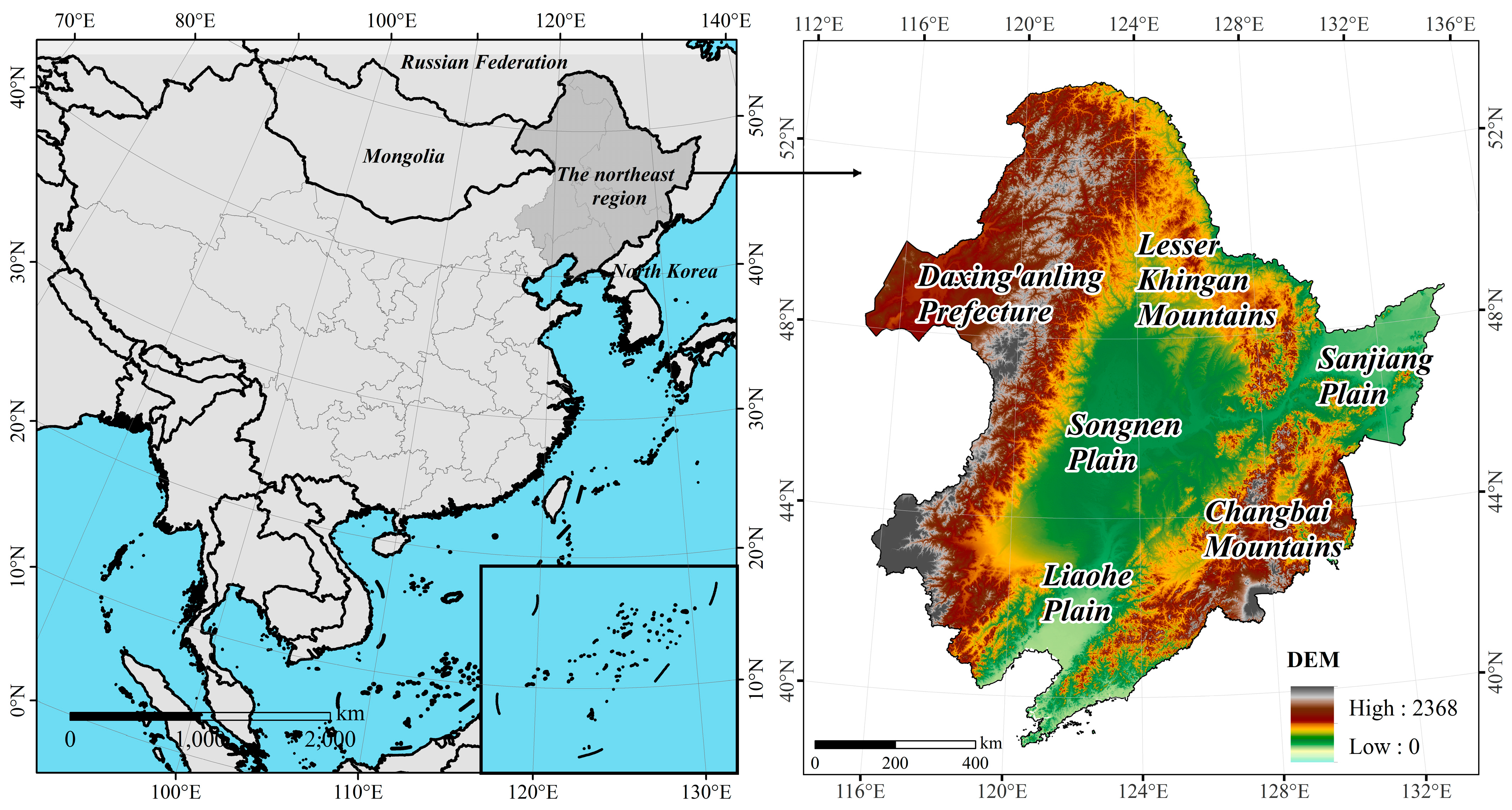
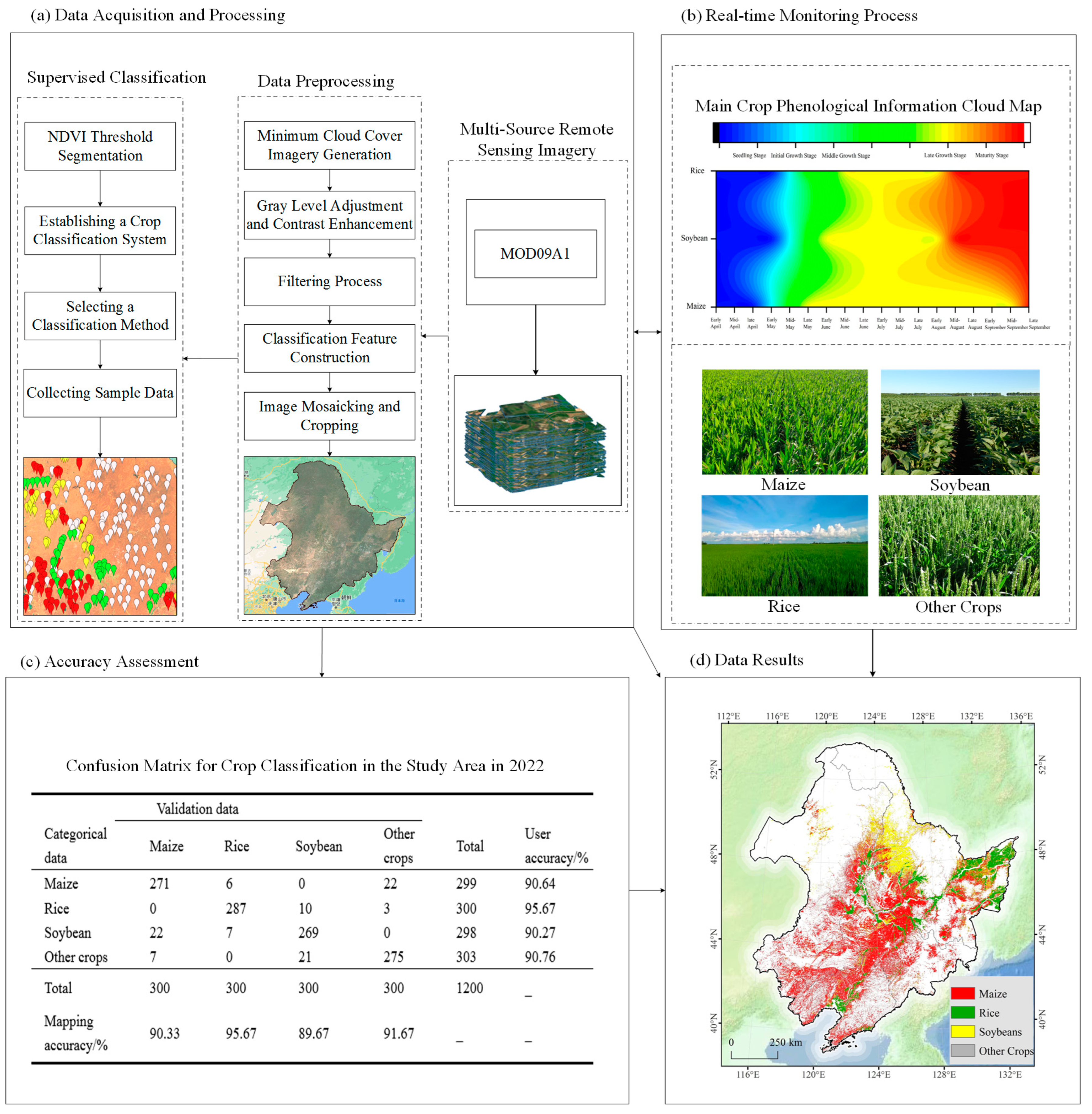
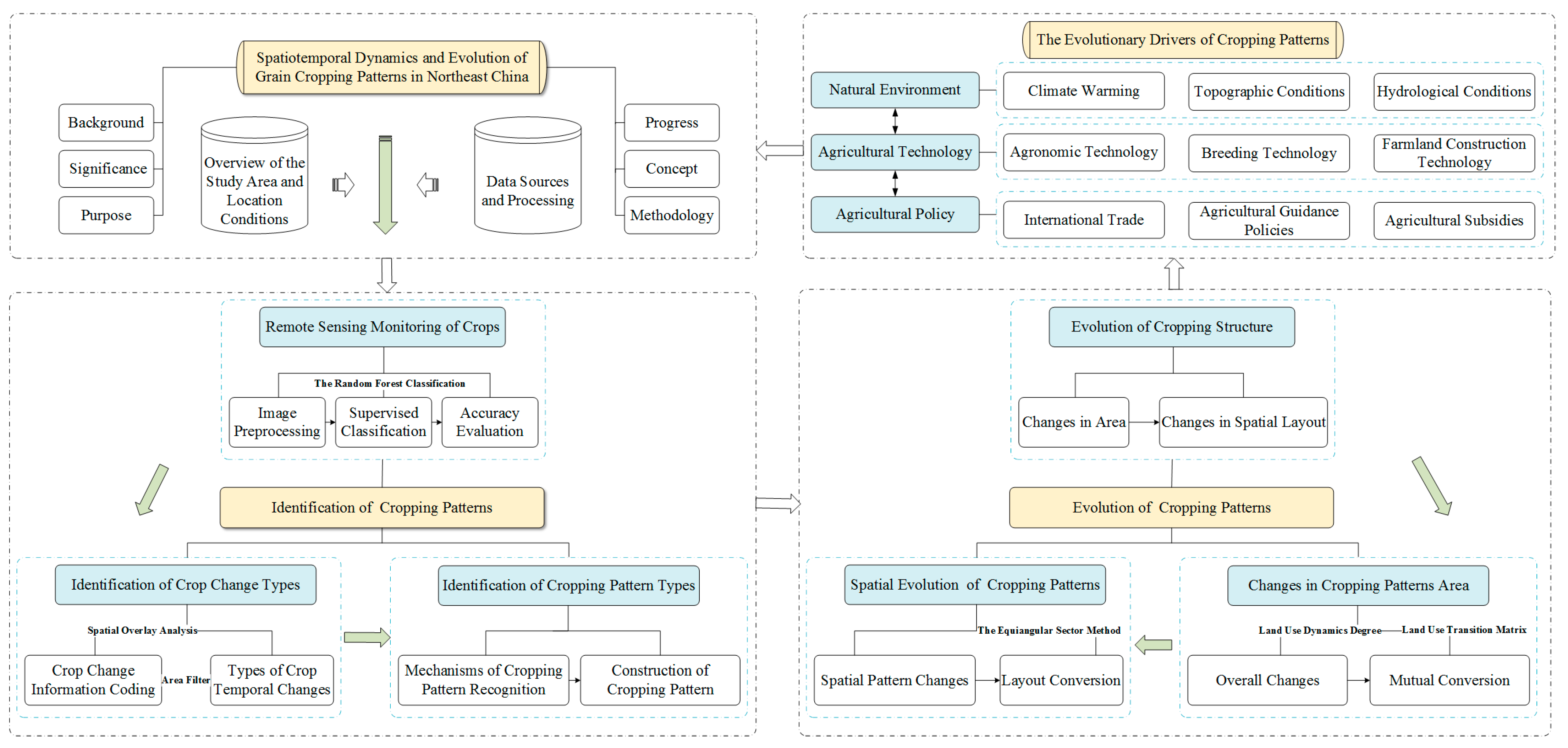
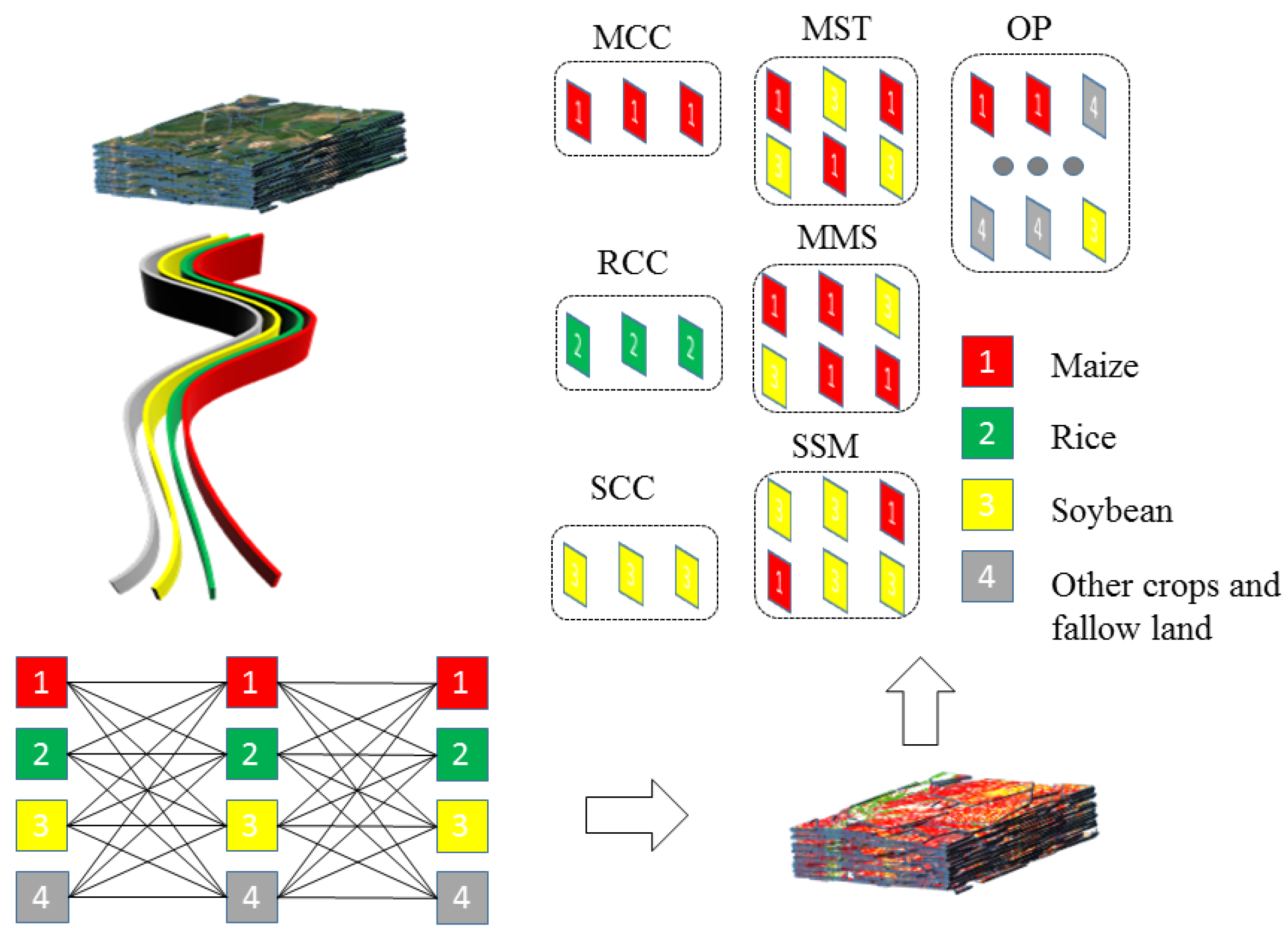

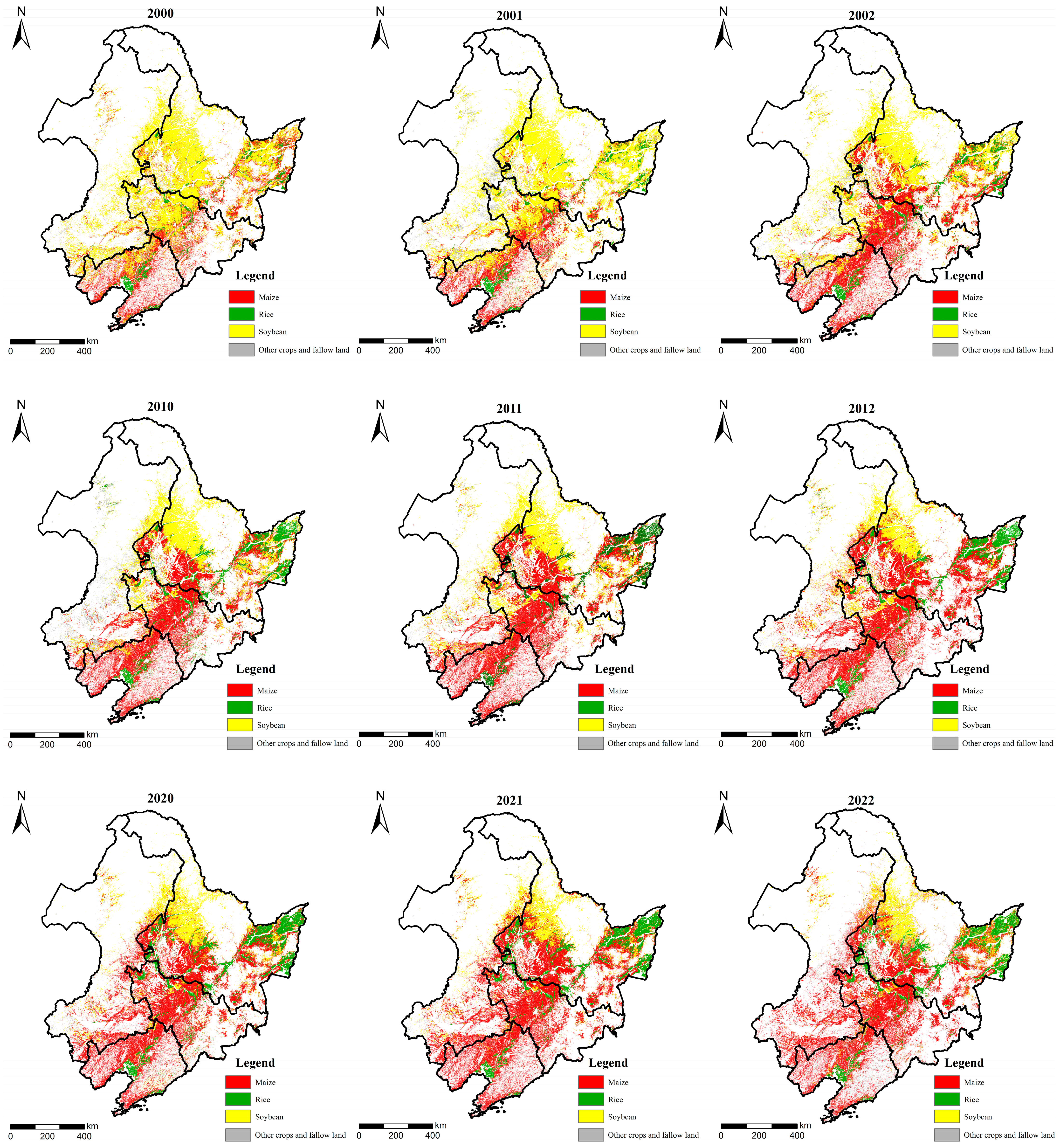
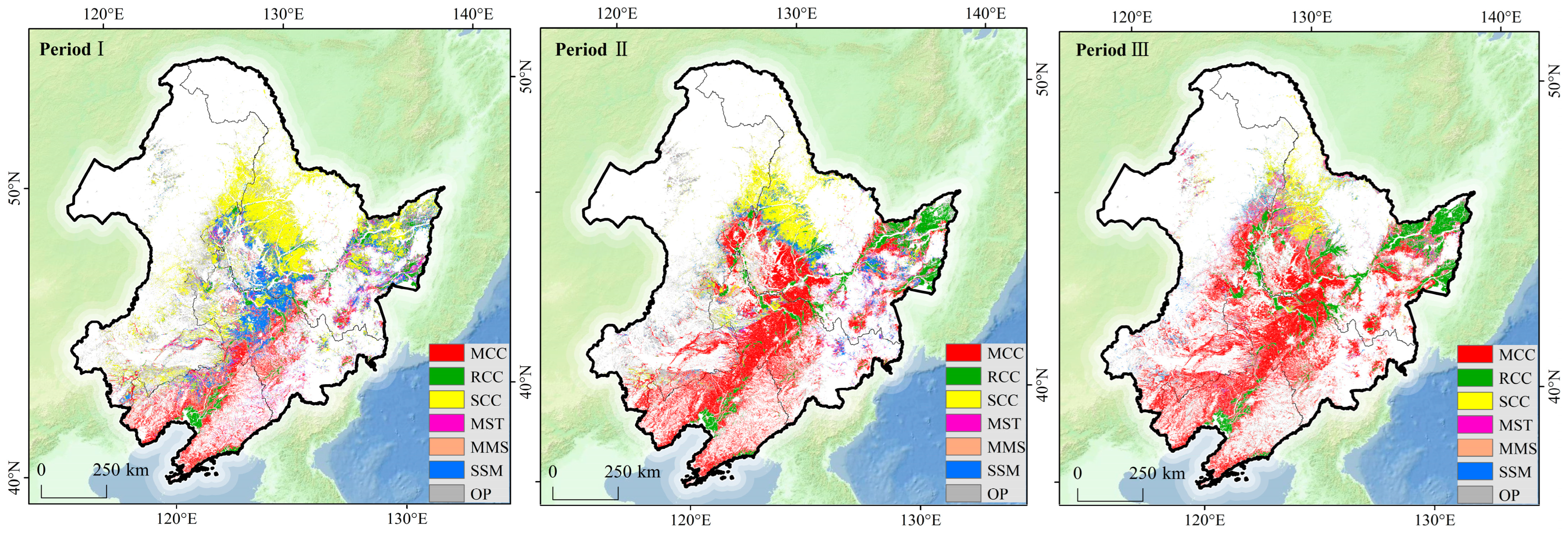
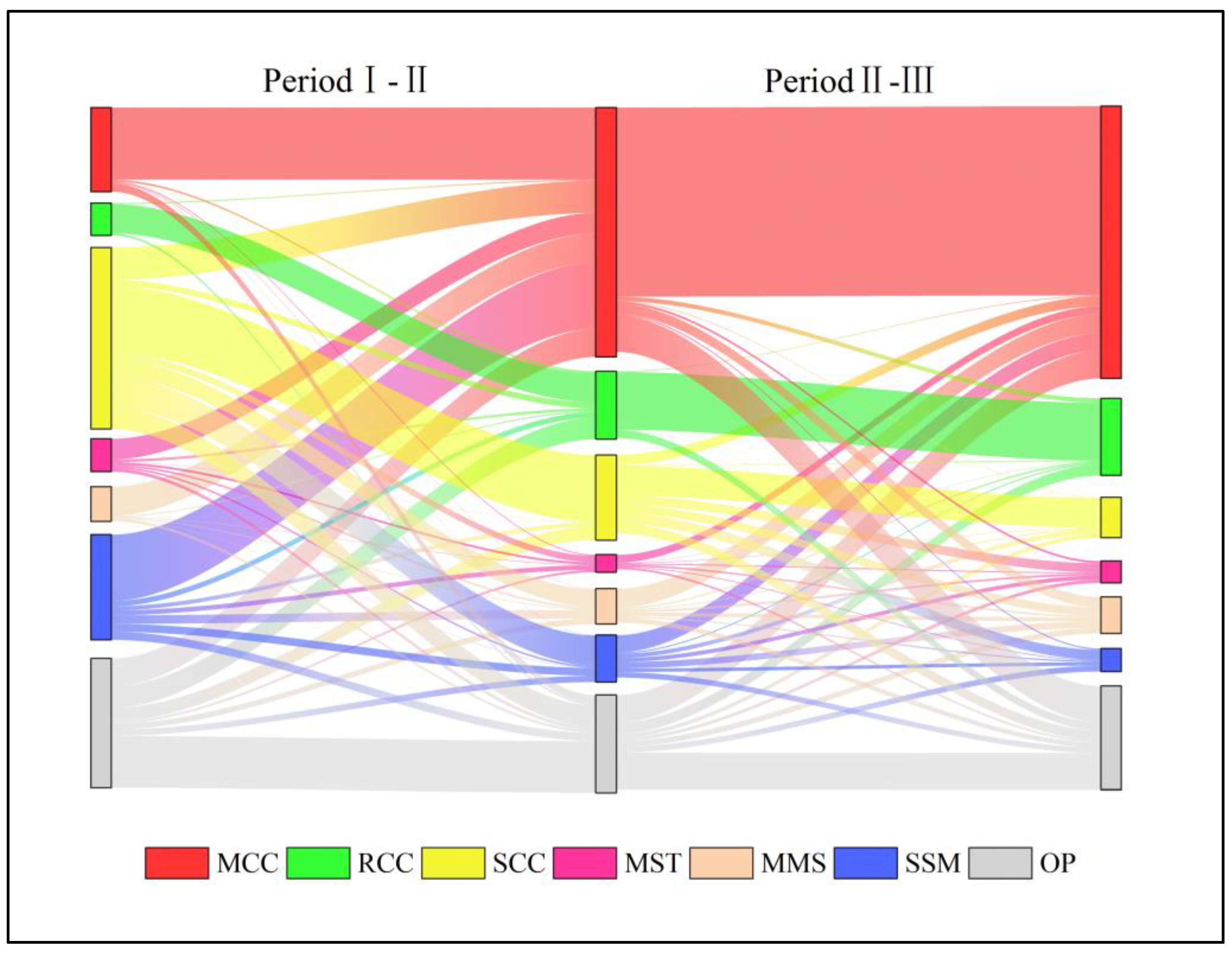
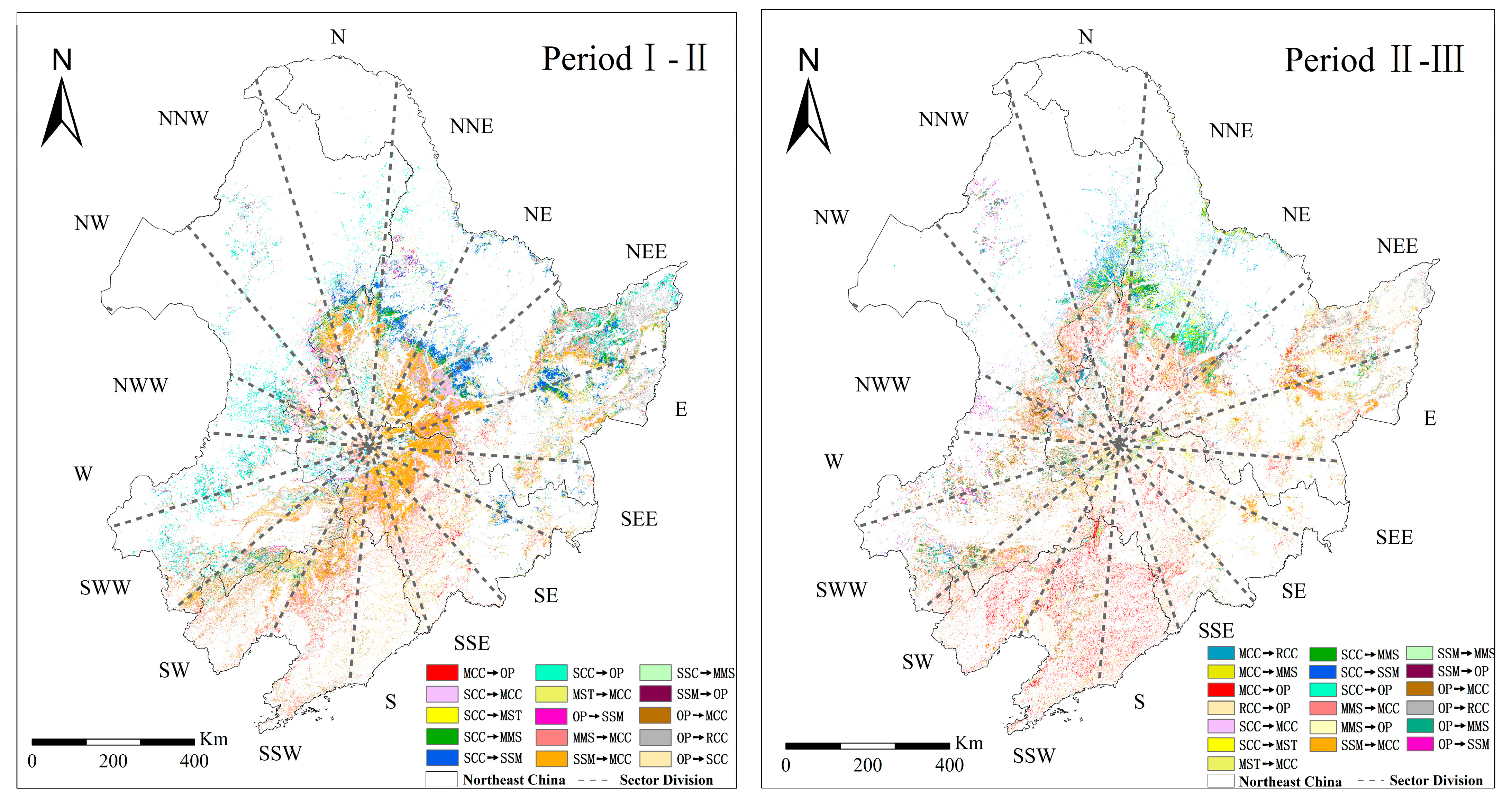

| Type of Cropping Pattern | Period I | Period II | Period III | Land Use Dynamic Degree (%) | |||||
|---|---|---|---|---|---|---|---|---|---|
| Area (km2) | Ratio (%) | Area (km2) | Ratio (%) | Area (km2) | Ratio (%) | Period I–II | Period II–III | Period I–III | |
| MCC | 56,231.50 | 15.22 | 156,449.25 | 42.21 | 173,083.50 | 45.83 | 17.82 | 1.06 | 20.78 |
| RCC | 19,460.50 | 5.27 | 41,645.75 | 11.24 | 51,371.25 | 13.60 | 11.40 | 2.34 | 16.40 |
| SCC | 108,296.00 | 29.31 | 51,106.25 | 13.79 | 29,342.50 | 7.77 | −5.28 | −4.26 | −7.29 |
| MST | 20,486.75 | 5.54 | 10,719.75 | 2.89 | 14,417.00 | 3.82 | −4.77 | 3.45 | −2.96 |
| MMS | 21,331.50 | 5.77 | 21,503.25 | 5.80 | 24,149.25 | 6.39 | 0.08 | 1.23 | 1.32 |
| SSM | 63,169.50 | 17.10 | 28,253.75 | 7.62 | 16,021.75 | 4.24 | −5.53 | −4.33 | −7.46 |
| OP | 80,519.00 | 21.79 | 60,959.75 | 16.45 | 69,250.50 | 18.34 | −2.43 | 1.36 | −1.40 |
| Total | 369,494.75 | 100.00 | 370,637.75 | 100.00 | 377,635.75 | 100.00 | 0.02 | 0.09 | 0.11 |
Disclaimer/Publisher’s Note: The statements, opinions and data contained in all publications are solely those of the individual author(s) and contributor(s) and not of MDPI and/or the editor(s). MDPI and/or the editor(s) disclaim responsibility for any injury to people or property resulting from any ideas, methods, instructions or products referred to in the content. |
© 2024 by the authors. Licensee MDPI, Basel, Switzerland. This article is an open access article distributed under the terms and conditions of the Creative Commons Attribution (CC BY) license (https://creativecommons.org/licenses/by/4.0/).
Share and Cite
Du, G.; Han, L.; Yao, L.; Faye, B. Spatiotemporal Dynamics and Evolution of Grain Cropping Patterns in Northeast China: Insights from Remote Sensing and Spatial Overlay Analysis. Agriculture 2024, 14, 1443. https://doi.org/10.3390/agriculture14091443
Du G, Han L, Yao L, Faye B. Spatiotemporal Dynamics and Evolution of Grain Cropping Patterns in Northeast China: Insights from Remote Sensing and Spatial Overlay Analysis. Agriculture. 2024; 14(9):1443. https://doi.org/10.3390/agriculture14091443
Chicago/Turabian StyleDu, Guoming, Le Han, Longcheng Yao, and Bonoua Faye. 2024. "Spatiotemporal Dynamics and Evolution of Grain Cropping Patterns in Northeast China: Insights from Remote Sensing and Spatial Overlay Analysis" Agriculture 14, no. 9: 1443. https://doi.org/10.3390/agriculture14091443
APA StyleDu, G., Han, L., Yao, L., & Faye, B. (2024). Spatiotemporal Dynamics and Evolution of Grain Cropping Patterns in Northeast China: Insights from Remote Sensing and Spatial Overlay Analysis. Agriculture, 14(9), 1443. https://doi.org/10.3390/agriculture14091443







